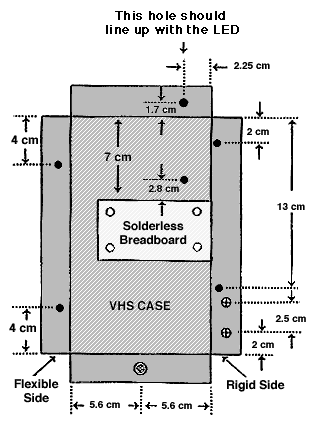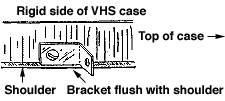 Hands On Physics
Hands On Physics
Haze
Core Project
Preparing the Case
Overview:
The goal of the core project is to build a good sun photometer (Visible
Haze Sensor, VHS-1). The first activity is the preparation of a video box
for the the sun photometer case. Careful measurement, marking, and hole
drilling are important for the proper functioning of this instrument.
See tools and materials for a complete
list of the parts required.
Preparing the Case:
The instructions given here apply to the specific video case described in
the Parts List and illustrated in the drilling guide shown below in Fig.
C2. Other cases will also work if they are not too flimsy. But you may need
to alter the position of the batteries and other items. Just be sure that
the distance from the roughened end of the LED to the hole in the case and
the diameter of the hole remain exactly 6.5 cm and 7.0 mm, respectively.

Figure C2
Hole Drilling Guide
CAUTION: Use appropriate safety procedures when drilling holes!
Be sure to place the case over a wood block before drilling (unless you
use a drill press with a hole for the drill to pass through). Hold the case
SECURELY when drilling or it will spin. Although a drill is best, since
the VHS case is very soft, holes can be formed with a sharp hobby knife.
These knifes are VERY sharp! Use great care when making holes with a hobby
knife! Avoid applying too much pressure or the knife blade may snap off!
- Refer to Fig. C2 and place the solderless
breadboard inside the case as shown. Place one end of the solderless breadboard
flush against the inside of the rigid side of the case. Slide the breadboard
along the inside of the case until its upper side is exactly 7 cm from the
inside of the front end of the case.
- When the breadboard is in the proper position, hold it securely and
twirl a 3/32-inch drill bit in each of the four holes to mark drill guides
in the bottom of the case. Check to make sure the breadboard was in the
proper position.
- Remove the breadboard and drill a 1/8-inch hole at each of the four
drill guides. Hold the case firmly while drilling. Don't worry about plastic
shavings that remain attached to the case. We'll remove them later.
- Close the case for this and the following steps. The upper side of
the case is the lid. Orient the case so the lid opens to the LEFT. This
means that the flexible side of the case is to the left and the rigid side
of the case is to the right. With the case oriented like this, place a piece
of masking tape on the upper end of the lid to indicate the upper end of
the case.
- With the case closed, use a small drill bit or scribe to mark drill
guides in the center of the flexible side of the case 4 cm from the top
and bottom edges.
- With the case closed, use a 5/32-inch bit or its metric equivalent
to drill a hole at each of the two drill guides you just marked. Hold the
case firmly while drilling. The plastic case is very soft, so drilling is
easy. (Don't worry about plastic shavings that remain attached to the case.
We'll remove them later.)
- Place an angle bracket along the rigid side of the top end of the
case (see Fig. 3 below). With the bracket held flush against the shoulder
extending from the bottom of the case, use the hole in the bracket as a
template to mark a drill guide. The hole will be around 16 mm from the top
end of the case. Repeat this procedure to mark a second drill guide in the
rigid side of the case 6.5 cm from the bottom end of the case

Figure C3
Position of Angle Brackets
- With the case closed, use an angle bracket to check the position of
both drill guides. It is VERY important that the side of the bracket is
flush with the lower edge of the case as shown in Fig.
C3. This will keep the bracket from moving after you attach it to the
case.
- Use a 5/32-inch bit or its metric equivalent to drill holes at the
two previously marked drill guides.
- Mark drill guides centered 1.8 and 4.5 cm from the bottom end of the
rigid side of the case.
- With the case closed, use a 5/16-inch drill bit or its metric equivalent
to drill holes at the two previously marked guides. Hold the case firmly
while drilling.
- Mark a single drill guide in the center of the bottom side of the
case (Fig. C2). Check to make sure you marked
the guide on the bottom end, not the top end, of the case.
With the case closed, use a 15/32-inch (best choice) or a 1/2-inch bit or
its metric equivalent to drill a hole at the previously marked guide. Hold
the case firmly while drilling.
- Carefully remove any plastic that remains attached to the edges of
any of the holes. A sharp hobby knife may be necessary.
CAUTION: Use care when using a knife to cut away any remaining plastic!
Note: Two more holes will be drilled later.
Previous Page || Up
a Level || Index || Next
Page